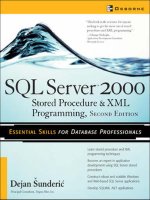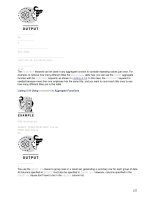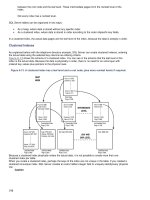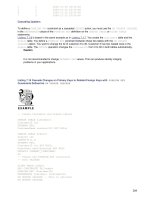SQL Server 2000 Stored Procedure Programming phần 10 ppt
Bạn đang xem bản rút gọn của tài liệu. Xem và tải ngay bản đầy đủ của tài liệu tại đây (328.45 KB, 68 trang )
Appendix B: Solutions to the Exercises
665
select @AcquisitionType = AcquisitionType
from AcquisitionType
where AcquisitionTypeId = @AcquisitionTypeid
insert everything
insert into #InventoryDenormalized(
InventoryId, Make, Model,
Location, Status , LeaseNumber ,
StartDate , EndDate , FirstName ,
LastName, Rent, Lease ,
Cost, AcquisitionType, AcquisitionDate)
values ( @InventoryId, @Make, @Model,
@Location, @Status, @LeaseNumber,
@StartDate, @EndDate, @FirstName,
@LastName, @Rent, @Lease,
@Cost, @AcquisitionType, @AcquisitionDate)
FETCH NEXT FROM @CrsrVar
INTO @Inventoryid,
@EquipmentId,
@LocationId ,
@StatusId,
@LeaseId ,
@LeaseScheduleId,
@OwnerId,
@Rent ,
@Lease ,
@Cost ,
@AcquisitionTypeID,
@AcquisitionDate
END
CLOSE @CrsrVar
DEALLOCATE @CrsrVar
select * from #InventoryDenormalized
drop table #InventoryDenormalized
return 0
CHAPTER 5. FUNCTIONS
Exercise 5.1
Create a Select statement that returns the quarter from the current
date in the following format: ‘3Q2000’.
Exercise 5.1 Solution
Use the following code:
Select DATENAME(q, GETDATE()) + 'Q' + DATENAME(yyyy, GETDATE())
Exercise 5.2
Create a table called ExpectedShippingDate that contains the
following fields:
▼ ExpectedShippingDateId (offset from the starting date)
■
ExpectedShippingDate
■
ExpectedShippingDateOfMonth
■
ExpectedShippingMonth
■
ExpectedShippingYear
▲
ExpectedShippingQuarter
The table should be filled with one record for each date since 1/1/2000.
Create a stored procedure Setup_ExpectedShippingDate to fill it.
Exercise 5.2 Solution
Use the following statement to create the table:
CREATE TABLE [dbo].[ExpectedShipDate] (
[ExpectedShipDateId] [smallint] NOT NULL ,
[ExpectedShipDate] [smalldatetime] NULL ,
[ExpectedShippingMonth] [tinyint] NULL ,
[ExpectedShippingDay] [tinyint] NULL ,
[ExpectedShippingYear] [smallint] NULL ,
666
SQL Server 2000 Stored Procedure Programming
[ExpectedShippingQuarter] [char] (6) NULL
) ON [PRIMARY]
GO
The table can be filled using the following stored procedure:
CREATE PROCEDURE Setup_ExpectedShipDate
@ExpectedShipDate smalldatetime = '1/1/2000',
@day_number smallint = 5000
as
declare @ExpectedShipDateId smallint
declare @ExpectedShippingMonth tinyint
declare @ExpectedShippingDay tinyint
declare @ExpectedShippingYear smallint
declare @ExpectedShippingQuarter char(6) not (4) anymore
declare @ExpectedShipDatecurrent smalldatetime
declare @intErrorCode int
set nocount on
select @intErrorCode = @@Error
If @intErrorCode = 0
begin
select @ExpectedShipDateId = 0,
@ExpectedShipDatecurrent = @ExpectedShipDate
select @intErrorCode = @@Error
end
while @intErrorCode = 0 and @day_number> 0
begin
If @intErrorCode = 0
begin
select @ExpectedShipDateId = @ExpectedShipDateId + 1,
@ExpectedShippingMonth = datepart (mm,
@ExpectedShipDatecurrent),
@ExpectedShippingDay = datepart (dd,
@ExpectedShipDatecurrent),
@ExpectedShippingYear = datepart (yy,
@ExpectedShipDatecurrent)
select @intErrorCode = @@Error
end
Appendix B: Solutions to the Exercises
667
If @intErrorCode = 0
begin
Set @ExpectedShippingQuarter = dateName (qq, @ExpectedShipDate)
+ 'Q' + dateName (yyyy, @ExpectedShipDate)
select @intErrorCode = @@Error
end
insert row
If @intErrorCode = 0
begin
insert into ExpectedShipDate (
ExpectedShipDateId, ExpectedShipDate,
ExpectedShippingMonth, ExpectedShippingDay,
ExpectedShippingYear, ExpectedShippingQuarter)
values (@ExpectedShipDateId, @ExpectedShipDatecurrent,
@ExpectedShippingMonth, @ExpectedShippingDay,
@ExpectedShippingYear, @ExpectedShippingQuarter)
Select @intErrorCode = @@Error
End
If @intErrorCode = 0
Begin
Select @day_number = @day_number - 1,
@ExpectedShipDatecurrent = @ExpectedShipDatecurrent + 1
Select @intErrorCode = @@Error
End
End
Return @intErrorCode
Go
Exercise 5.3
Create a table to store contact information. The last column should
contain a binary checksum value so that you can later see if the
record has changed.
668
SQL Server 2000 Stored Procedure Programming
Appendix B: Solutions to the Exercises
669
Exercise 5.3 Solution
The following code snippet shows a new contact table with the BC
field reserved for a binary checksum:
CREATE TABLE [Contact_with_BC] (
[ContactId] [int] IDENTITY (1, 1) NOT NULL ,
[FirstName] [varchar] (30) NOT NULL ,
[LastName] [varchar] (30) NOT NULL ,
[Phone] [typPhone] NULL ,
[Fax] [typPhone] NULL ,
[Email] [typEmail] NULL ,
[OrgUnitId] [smallint] NOT NULL ,
[UserName] [varchar] (50) NULL ,
BC int null
) ON [PRIMARY]
GO
The value in the BC column can be managed from a trigger:
CREATE TRIGGER trContact_with_BC_IU ON [dbo].[Contact_with_BC]
FOR INSERT, UPDATE
AS
update Contact_with_BC
set BC = BINARY_CHECKSUM(FirstName, LastName, Phone,
Fax, Email, OrgUnitId, UserName)
where ContactId in (select ContactId from inserted)
GO
You can test the table, function, and trigger in the following manner:
insert Contact_with_BC (FirstName, LastName, Phone, OrgUnitId)
values('Tom', 'Jones', '123-4567', 1)
select * from Contact_with_BC
update Contact_with_BC
set Phone = '313-1313'
where ContactId = 1
select * from Contact_with_BC
CHAPTER 6. COMPOSITE TRANSACT-SQL
CONSTRUCTS—BATCHES, SCRIPTS, AND
TRANSACTIONS
Exercise 6.1
Create a database script for the Asset database.
Exercise 6.1 Solution
1. Open Enterprise Manager.
2. Right-click the Asset database in the Console Tree pane.
3. Select All Tasks | Generate SQL Scripts.
4. Optionally make changes to default parameters, then click
OK to accept.
5. When the application prompts you, specify a name for the
script file to store the result.
Exercise 6.2
Create a database script for a single stored procedure in the Asset
database. Add a line of comment into the script and execute it.
Exercise 6.2 Solution
1. Open Enterprise Manager.
670
SQL Server 2000 Stored Procedure Programming
2. Right-click the stored procedure in the Asset database for
which you want to generate code.
3. Select All Tasks | Generate SQL Scripts.
4. The application displays a dialog box with a single stored
procedure selected in the Objects To Be Scripted list (see
Figure B-4). Click OK to accept the default parameters.
5. When the application prompts you, specify a name for the
script file to be used to store the result.
6. Start Query Analyzer.
7. Open the script file (see the result of File | Open in Figure B-5).
8. Add a line of comment (place ‘ ’ at the beginning of the line).
9. Execute the script (Query | Execute).
Appendix B: Solutions to the Exercises
671
Figure B-4. Generating a script for a single stored procedure
672
SQL Server 2000 Stored Procedure Programming
Exercise 6.3
What is the problem with the following script?
select *
from Eq
/*
Go
delete Eq
where EqId > 100
Go
*/
select *
from EqType
Figure B-5. A script for prListLeasedAssets
How can you fix it?
Exercise 6.3 Solution
The problem is that this script contains a comment that spans multiple
batches. If you execute this script from Query Analyzer, it is divided
into three batches. The first and the last batch do not execute because
they contain incomplete comments. The second batch executes (contrary
to expectations) and will purge a good portion of the Eq table.
You can fix the problem by changing the location of the comment
markers:
select *
from Eq
Go
/*
delete Eq
where EqId > 100
*/
Go
select *
from EqType
You can also “comment-out” the Go command by placing two
dashes at the beginning of the line with the Go statement:
select *
from Eq
/*
Go
delete Eq
where EqId > 100
Go
*/
select *
from EqType
Appendix B: Solutions to the Exercises
673
Exercise 6.4
How do the Rollback Transaction and Commit Transaction
statements affect @@trancount?
Exercise 6.4 Solution
Commit Transaction decreases @@trancount by one. If
@@trancount then equals 1, it also commits changes to the
database. Rollback Transaction discards all changes and sets
@@trancount to 0.
Exercise 6.5
Create a table with bank account information and then a stored
procedure for transferring funds from one account to another. The
stored procedure should contain transaction processing.
Exercise 6.5 Solution
Use the following code:
CREATE TABLE [dbo].[Account] (
[AccountId] [char] (10) NOT NULL ,
[Balance] [money] NOT NULL ,
[AccountTypeId] [int] NOT NULL
)
GO
ALTER TABLE [dbo].[Account] WITH NOCHECK ADD
CONSTRAINT [PK_Account] PRIMARY KEY NONCLUSTERED
(
[AccountId]
)
GO
CREATE PROCEDURE prTransferFunds
@From char(20),
674
SQL Server 2000 Stored Procedure Programming
@To char(20),
@Amount money
AS
Begin Transaction
update Account
Set Balance = Balance - @Amount
where AccountId = @From
if @@Error <> 0 GOTO ERR
update Account
Set Balance = Balance + @Amount
where AccountId = @To
if @@Error <> 0 GOTO ERR
Commit Transaction
return 0
ERR:
Rollback Transaction
Raiserror('Unable to transfer funds!', 16, 1)
return 1
GO
Exercise 6.6
Is it okay to span a transaction over multiple batches?
Exercise 6.6 Solution
Technically, it is possible to span a transaction over multiple batches,
because SQL Server records them on the level of the user connection.
However, it is not a recommended practice, because SQL Server
blocks resources until the transaction is completed. It is important
to complete the transaction as quickly as possible to release the
blocked resources.
Appendix B: Solutions to the Exercises
675
676
SQL Server 2000 Stored Procedure Programming
CHAPTER 7. DEBUGGING AND ERROR HANDLING
Exercise 7.1
Add debugging code to the following stored procedure:
Alter Procedure prSpaceUsedByTables_1
loop through table names in current database
display info about amount of space used by each table
As
Set nocount on
declare @MaxCounter int,
@Counter int,
@TableName sysname
Create table #Tables (
Id int identity(1,1),
TableName sysname)
collect table names
insert into #Tables(TableName)
select name
from sysobjects
where xtype = 'U'
prepare loop
Select @MaxCounter = Max(Id),
@Counter = 1
from #Tables
while @Counter <= @MaxCounter
begin
get table name
select @TableName = TableName
from #Tables
where Id = @Counter
display space used
Appendix B: Solutions to the Exercises
677
exec sp_spaceused @TableName
set @Counter = @Counter + 1
end
drop table #Tables
Exercise 7.1 Solution
The new stored procedure is saved under a different name:
Create Procedure prSpaceUsedByTables_2
loop through table names in current database
display info about amount of space used by each table
@debug int = 0
As
Set nocount on
declare @MaxCounter int,
@Counter int,
@TableName sysname
Create table #Tables (
Id int identity(1,1),
TableName sysname)
collect table names
insert into #Tables(TableName)
select name
from sysobjects
where xtype = 'U'
if @debug <> 0
select * from #Tables
prepare loop
Select @MaxCounter = Max(Id),
@Counter = 1
from #Tables
if @debug <> 0
select @MaxCounter MaxCounter
while @Counter <= @MaxCounter
begin
get table name
select @TableName = TableName
from #Tables
where Id = @Counter
if @debug <> 0
select @TableName TableName
display space used
exec sp_spaceused @TableName
set @Counter = @Counter + 1
end
Drop Table #Tables
Exercise 7.2
Execute the stored procedure through Query Analyzer to review
debugging information.
Exercise 7.2 Solution
Use Query Analyzer, as shown in Figure B-6.
Exercise 7.3
Run the stored procedure through TSQL Debugger to try debugging.
Exercise 7.3 Solution
Right-click the procedure in the Object Browser of Query Analyzer.
Click Debug and the program will prompt you to specify the
parameters values, as shown in Figure B-7.
678
SQL Server 2000 Stored Procedure Programming
Appendix B: Solutions to the Exercises
679
Figure B-6. Executing a stored procedure in Query Analyzer
Figure B-7. Debug Procedure dialog box
680
SQL Server 2000 Stored Procedure Programming
Set the value of @debug parameter to “0” and click on Execute. The
program will launch the T-SQL Debugger window (see Figure B-8).
You can now step through the procedure and investigate its local and
global variables.
Exercise 7.4
What is the problem with the following code snippet?
update LeaseSchedule
Set PeriodicTotalAmount = PeriodicTotalAmount + @mnyLease
where LeaseId = @intLeaseId
If @@Error <> 0
begin
Print 'Unexpected error occurred: '
+ Convert(varchar, @@Error)
Rollback transaction
Return @@Error
end
Exercise 7.4 Solution
The value of the @@Error global variable is set after every single
Transact-SQL statement, including the If statement that is checking
its value. Therefore, the Print statement cannot display the Error
number as a part of the message. A better solution is the following:
Update LeaseSchedule
Set PeriodicTotalAmount = PeriodicTotalAmount + @mnyLease
Where LeaseId = @intLeaseId
Select @intErrorCode = @@Error
If @intErrorCode <> 0
Begin
Print 'Unexpected error occurred: '
+ Convert(varchar, @intErrorCode)
Rollback transaction
Return @intErrorCode
End
Exercise 7.5
Change the stored procedure from Exercise 6.5 so that it complies
with the error handling solution proposed in this chapter.
Exercise 7.5 Solution
Use the following code:
CREATE PROCEDURE prTransferFunds_2
@From char(20),
@To char(20),
@Amount money,
@debug int = 0
AS
Appendix B: Solutions to the Exercises
681
Figure B-8. T-SQL Debugger window
set nocount on
Declare @intErrorCode int,
@intTransactionCountOnEntry int,
@chvProcedure sysname
Set @chvProcedure = 'prTransferFunds_2'
If @debug <> 0
Select '**** '+ @chvProcedure + ' START ****'
Select @intErrorCode = @@Error
If @intErrorCode = 0
Begin
Select @intTransactionCountOnEntry = @@TranCount
BEGIN TRANSACTION
End
If @intErrorCode = 0
Begin
update Account
Set Balance = Balance - @Amount
where AccountId = @From
select @intErrorCode = @@Error
End
If @intErrorCode = 0
Begin
Update Account
Set Balance = Balance + @Amount
Where AccountId = @To
Select @intErrorCode = @@Error
End
682
SQL Server 2000 Stored Procedure Programming
If @@TranCount > @intTransactionCountOnEntry
Begin
If @intErrorCode = 0
COMMIT TRANSACTION
Else
ROLLBACK TRANSACTION
End
If @debug <> 0
Select '**** '+ @chvProcedure + ' END ****'
Return @intErrorCode
Exercise 7.6
Take the stored procedure from exercise 4.7 and wrap it in the error
handling solution described in this chapter.
Exercise 7.6 Solution
Use the following code:
Create Procedure prSpaceUsedByTables_2
loop through table names in current database
display info about amount of space used by each table
@debug int = 0
As
set nocount on
Declare @intErrorCode int,
@intTransactionCountOnEntry int,
@chvProcedure sysname,
@MaxCounter int,
@Counter int,
@TableName sysname
set @chvProcedure = 'prSpaceUsedByTables_2'
Appendix B: Solutions to the Exercises
683
684
SQL Server 2000 Stored Procedure Programming
if @debug <> 0
select '**** '+ @chvProcedure + ' START ****'
Select @intErrorCode = @@Error
If @intErrorCode = 0
Begin
Create table #Tables (
Id int identity(1,1),
TableName sysname)
Select @intErrorCode = @@Error
End
If @intErrorCode = 0
Begin
collect table names
insert into #Tables(TableName)
select name
from sysobjects
where xtype = 'U'
Select @intErrorCode = @@Error
End
If @intErrorCode = 0
Begin
prepare loop
Select @MaxCounter = Max(Id),
@Counter = 1
from #Tables
Select @intErrorCode = @@Error
End
Appendix B: Solutions to the Exercises
685
while @intErrorCode = 0 and @Counter <= @MaxCounter
begin
If @intErrorCode = 0
Begin
get table name
select @TableName = TableName
from #Tables
where Id = @Counter
Select @intErrorCode = @@Error
End
If @intErrorCode = 0
display space used
exec @intErrorCode = sp_spaceused @TableName
set @Counter = @Counter + 1
end
drop table #Tables
if @debug <> 0
select '**** '+ @chvProcedure + ' END ****'
return @intErrorCode
CHAPTER 9. SPECIAL TYPES OF PROCEDURES
Exercise 9.1
Create a function that returns the last date of a month containing a
specified date.
686
SQL Server 2000 Stored Procedure Programming
Exercise 9.1 Solution
Use the following code:
CREATE FUNCTION fnLastDateOfMonth
returns last date of the current month
(
@dtmDate datetime
)
RETURNS datetime
AS
BEGIN
declare @inyDay tinyint
declare @dtmDateNew datetime
set @inyDay = Day(@dtmDate)
first day of the current month
set @dtmDateNew = DateAdd( day, - @inyDay + 1, @dtmDate)
first day of the next month
set @dtmDateNew = DateAdd( month, 1, @dtmDateNew)
last day of the current month
set @dtmDateNew = DateAdd( day, - 1, @dtmDateNew)
RETURN (@dtmDateNew)
END
You can test the function using a simple Select statement:
SELECT [Asset].[dbo].[fnLastDateOfMonth]('3/31/2000')
Exercise 9.2
Create a function that returns a table containing the last days of
months in a specified number of following years.
Appendix B: Solutions to the Exercises
687
Exercise 9.2 Solution
Use the following code:
CREATE FUNCTION dbo.fnListOfLastDatesMonth
( @dtmStartDate datetime,
@inyCountYears tinyint
)
RETURNS @tblDates table
(
LastDate datetime
)
AS
BEGIN
declare @dtmEndDate datetime
declare @dtmDate datetime
set @dtmEndDate = DATEADD(year, @inyCountYears, @dtmStartDate)
set @dtmDate = @dtmStartDate
while @dtmDate < @dtmEndDate
begin
insert into @tblDates
values(dbo.fnLastDateOfMonth(@dtmDate))
set @dtmDate = DATEADD(month, 1, @dtmDate)
end
RETURN
END
688
SQL Server 2000 Stored Procedure Programming
You can test functions that return a table in any statement that
uses a rowset provider, such as the From clause of a Select
statement:
select * from dbo.fnListOfLastDatesMonth ('1/1/2000', 3)
Exercise 9.3
Create a trigger on the Inventory table that will record in the
ActivityLog table the user who is deleting assets from the database.
The log should contain the user name of the person deleting records,
the date of the deletion, and the IDs of the assets deleted.
Exercise 9.3 Solution
Use the following code:
Create Trigger trInventory_D
On dbo.Inventory
For Delete
As
record in activity log each deletion of asset in Inventory table
Insert into ActivityLog( Activity,
LogDate,
UserName,
Note)
select 'ASSET DELETED',
GetDate(),
USER_NAME(),
'InventoryId = ' + Convert(varchar, InventoryId)
from deleted
Exercise 9.4
How can you disable nested and recursive triggers in SQL Server?
Appendix B: Solutions to the Exercises
689
Exercise 9.4 Solution
Execute sp_configure as follows:
exec sp_configure 'nested triggers', 0
exec sp_configure 'recursive triggers', 0
Exercise 9.5
How can an administrator temporarily disable a trigger to allow the
performance of administrative activities on a table?
Exercise 9.5 Solution
Use the following command:
ALTER TABLE Order DISABLE TRIGGER trOrders_IU
Exercise 9.6
Create a view for displaying denormalized information contained
in the Inventory table. Design an instead-of insert trigger on the view
to accommodate uploading of Inventory information from an
external source.
Exercise 9.6 Solution
You can use the Create View Wizard or any other tool to join tables
and create the view:
SELECT Inventory.Inventoryid, Equipment.Make, Equipment.Model,
Location.Location, Status.Status, Contact.FirstName, Contact.LastName,
Inventory.Cost, AcquisitionType.AcquisitionType, Location.Address,
Location.City, Location.ProvinceId, Location.Country, EqType.EqType,
Contact.Phone, Contact.Fax, Contact.Email, Contact.UserName, Inventory.Rent,
Inventory.EquipmentId, Inventory.LocationId, Inventory.StatusId,
Inventory.OwnerId, Inventory.AcquisitionTypeID, Contact.OrgUnitId









